U.S. Tactical Nuclear Weapons’ Attacks against Non-Nuclear States?
Washington's Planned Nuclear Attack against Libya, ordered by Bill Clinton
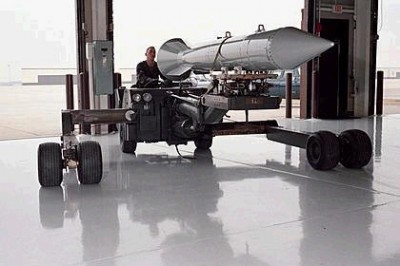
All Global Research articles can be read in 51 languages by activating the Translate Website button below the author’s name.
To receive Global Research’s Daily Newsletter (selected articles), click here.
Click the share button above to email/forward this article to your friends and colleagues. Follow us on Instagram and Twitter and subscribe to our Telegram Channel. Feel free to repost and share widely Global Research articles.
***
This article first published on March 30, 2011 documents an issue of significance in the current context (See the latest Nuclear Posture Review documents) namely:
a planned nuclear attack against a non-nuclear State in 1996, using a mini-nuke, namely a tactical earth penetrating tactical nuclear weapon.
Michel Chossudovsky, August 23, 2023, September 16, 2023
***
A war on Libya has been on the drawing board of the Pentagon for more than 20 years. Using nukes against Libya was first envisaged in 1996.
On April 14th 1986, Ronald Reagan ordered a series of bombings directed against Libya under “Operation El Dorado Canyon”, in reprisal for an alleged Libya-sponsored terrorist bombing of a Berlin discotheque. The pretext was fabricated. During these air raids, which were condemned by both France and Italy, Qadhafi’s residence was bombed killing his younger daughter.
Barely acknowledged by the Western media, a planned attack on Libya using nuclear weapons had been contemplated by the Clinton Administration in 1996, at the height of the Monica Lewinsky scandal.
The Department of Defense had developed a new generation of bunker buster tactical nuclear weapons for use in the Middle East and Central Asia:
“Military officials and leaders of America’s nuclear weapon laboratories [had] urged the US to develop a new generation of precision low-yield nuclear weapons… which could be used in conventional conflicts with third-world nations.” (Federation of American Scientists, 2001, emphasis added)
The B61-11 earth-penetrating weapon with a nuclear warhead had not been tested. It was part of the B61 series, coupled with a so-called “low yield” nuclear warhead. According to US military sources: “If used in North Korea, the radioactive fallout [of the B61-11] could drift over nearby countries such as Japan.” (B61-11 Earth-Penetrating Weapon, Globalsecurity.org). The B61-11 earth-penetrating version of the B61 was configured initially to have a “low” 10 kiloton yield, 66.6 percent of a Hiroshima bomb, for post-Cold War battlefield operations in the Middle East and Central Asia.
The Pentagon’s Plan to Nuke Libya
The B61-11 tactical nuclear weapon was slated by the Pentagon to be used in 1996 against the “Qadhafi regime”:
“Senior Pentagon officials ignited controversy last April [1996] by suggesting that the earth-penetrating [nuclear] weapon would soon be available for possible use against a suspected underground chemical factory being built by Libya at Tarhunah. This thinly-veiled threat came just eleven days after the United States signed the African Nuclear Weapons Free Zone Treaty, designed to prohibit signatories from using or threatening to use nuclear weapons against any other signatory, including Libya.” (David Muller, Penetrator N-Bombs, International Action Center, 1997)
Tarbunah has a population of more than 200,000 people, men, women and children. It is about 60 km East of Tripoli. Had this “humanitarian bomb” (with a “yield” or explosive capacity of two-thirds of a Hiroshima bomb) been launched on this “suspected” WMD facility, it would have resulted in tens of thousands of deaths, not to mention the nuclear fallout.
Image: Harold Palmer Smith Junior

The man behind this diabolical project to nuke Libya was Assistant Secretary of Defense Harold Palmer Smith Junior. “Even before the B61 came on line, Libya was identified as a potential target”. (Bulletin of the Atomic Scientists – September/ October 1997, p. 27, emphasis added)
Harold Palmer Smith had been appointed by President Bill Clinton to oversee nuclear, chemical, and biological defense programs with a focus on “the reduction and maintenance of the US arsenal of nuclear weapons”. From the outset, his actual mandate was not to “reduce” but to “increase” the nuclear arsenal by promoting the development of a new generation of “harmless” mini-nukes for use in the Middle East war theater.
“Testing” the B61-11 Nuclear Bomb on an Actual Country
The Department of Defense’s objective under Harold Smith’s advice was to fast-track the “testing” of the B61-11 nuclear bomb on an actual country:
Five months after [Assistant Defense Secretary] Harold Smith called for an acceleration of the B61-11 production schedule, he went public with an assertion that the Air Force would use the B61-11 [nuclear weapon] against Libya’s alleged underground chemical weapons plant at Tarhunah if the President decided that the plant had to be destroyed. “We could not take [Tarhunah] out of commission using strictly conventional weapons,” Smith told the Associated Press. The B61-11 “would be the nuclear weapon of choice,” he told Jane’s Defence Weekly.
Smith gave the statement during a breakfast interview with reporters after Defense Secretary William Perry had earlier told a Senate Foreign Relations Committee hearing on chemical or biological weapons that the U.S. retained the option of using nuclear weapons against countries armed with chemical and biological weapons. (http://www.nukestrat.com/us/afn/B61-11.htm, emphasis added)
While the Pentagon later denied its intention to bomb Libya’s Tarbunah plant, it nonetheless confirmed that “Washington would not rule out using nuclear weapons [against Libya]”. (Ibid., emphasis added.)
Nukes and Mini-Nukes: Iraq and Afghanistan
The US military contends that “mini-nukes” are “humanitarian bombs” which minimize “collateral damage”. According to scientific opinion on contract to the Pentagon, they are “harmless to the surrounding civilian population because the explosion is underground.”
The B61-11 is a bona fide thermonuclear bomb, a Weapon of Mass Destruction (WMD) in the real sense of the word.
Military documents distinguish between the Nuclear Earth Penetrator (NEP) and the “mini-nuke”, which are nuclear weapons with a yield of less than 10 kilotons (two-thirds of a Hiroshima bomb). The NEP can have a yield of up to a 1000 kilotons, or seventy times a Hiroshima bomb.
This distinction between mini-nukes and the NEP is in many regards misleading. In practice there is no dividing line. We are broadly dealing with the same type of weaponry: the B61-11 has several “available yields”, ranging from “low yields” of less than one kiloton, to mid-range, and up to the 1000 kiloton bomb.
In all cases, the radioactive fallout is devastating. Moreover, the B61 series of thermonuclear weapons includes several models with distinct specifications: the B61-11, the B61-3, B61- 4, B61-7 and B61-10. Each of these bombs has several “available yields”.
What is contemplated for theater use is the “low yield” 10 kt bomb, two-thirds of a Hiroshima bomb.
The Libya 1997 “Nuclear Option” Had Set the Stage…
Neither the Bush nor the Obama administrations have excluded using thermonuclear bunker buster bombs in the Middle East war theater. These weapons were specifically developed for use in post Cold War “conventional conflicts with third world nations”. They were approved for use in the conventional war theater by the US Senate in 2002, following the adoption of the 2001 Nuclear Posture Review.
In October 2001, in the immediate wake of 9/11, Defense Secretary Donald Rumsfeld envisaged the use of the B61-11 in Afghanistan. The stated targets were Al Qaeda cave bunkers in the Tora Bora mountains.
Rumsfeld stated at the time that while the “conventional” bunker buster bombs “‘are going to be able to do the job’… he did not rule out the eventual use of nuclear weapons.” (Quoted in the Houston Chronicle, 20 October 2001, emphasis added.)
The use of the B61-11 was also contemplated during the 2003 bombing and invasion of Iraq. In this regard, the B61-11 was described as “a precise, earth-penetrating low-yield nuclear weapon against high-value underground targets”, which included Saddam Hussein’s underground bunkers:
“If Saddam was arguably the highest value target in Iraq, then a good case could be made for using a nuclear weapon like the B61-11 to assure killing him and decapitating the regime.” (Defense News, December 8, 2003, emphasis added)
“All options are on the table”… Sheer madness. Nukes to implement “regime change”… What Rumsfeld had proposed, as part of a “humanitarian mandate”, was the use of a nuclear bomb to “take out” the president of a foreign country.
[Author’s note: There is no documentary evidence that the B61-11 was used against Iraq.]
Is a Nuclear Attack on Libya Still on the Pentagon’s Drawing Board?
“The Coalition of the Willing” under US-NATO mandate is currently involved in “a humanitarian war” on Libya to “protect the lives of innocent civilians”.
Is the use of a nuclear bomb excluded under the Alliance’s R2P (Responsibility to Protect) Doctrine?
The Bush administration’s 2001 nuclear doctrine contained specific “guidelines” regarding “preemptive” nuclear strikes against several countries in the broader Middle East Central Asian region, which explictly included Libya.
As revealed by William Arkin in early 2002, “The Bush administration, in a secret policy review… [had] ordered the Pentagon to draft contingency plans for the use of nuclear weapons [the 2001 Nuclear Posture Review approved by the Senate in late 2002] against at least seven countries, naming not only Russia and the “axis of evil”–Iraq, Iran, and North Korea–but also China, Libya and Syria.” (See William Arkin, “Thinking the Unthinkable”, Los Angeles Times, 9 March 2002)
In addition, the U.S. Defense Department has been told to prepare for the possibility that nuclear weapons may be required in some future Arab-Israeli crisis. And, it is to develop plans for using nuclear weapons to retaliate against chemical or biological attacks, as well as “surprising military developments” of an unspecified nature. These and a host of other directives, including calls for developing bunker-busting mini-nukes and nuclear weapons that reduce collateral damage, are contained in a still-classified document called the Nuclear Posture Review (NPR), which was delivered to Congress on Jan. 8. (ibid)
The preemptive nuclear doctrine (DJNO) –endorsed by the Obama Administration– allows for the preemptive use of “mini nukes” in conventional war theaters directed against “rogue states”. While the “guidelines” do not exclude other (more deadly) categories of nukes in the US/NATO nuclear arsenal, Pentagon “scenarios” in the Middle East and North Africa are currently limited to the use of tactical nuclear weapons including the B61-11 bunker buster bomb.
The fact that Libya had been singled out by the Pentagon for a possible 1997 mini-nuke “trial run” was a significant element in the formulation of the 2001 Nuclear Posture Review (NPR).
It is worth noting that tactical B61 nuclear weapons have also been deployed by America’s NATO partners: five European “non-nuclear states”, including Belgium, The Netherlands and Italy, which are directly participating in the Libya bombing campaign, have B61 mini-nukes stockpiled and deployed under national command in their respective military bases. (Michel Chossudovsky, Europe’s Five “Undeclared Nuclear Weapons States“, February 10, 2010)
These European-based mini-nukes are earmarked for targets in the Middle East. While Libya is not mentioned, according to “NATO strike plans”, the European-based thermonuclear B61 bunker buster bombs could be launched “against targets in Russia or countries in the Middle East such as Syria and Iran” (quoted in National Resources Defense Council, Nuclear Weapons in Europe, February 2005).
In the context of the ongoing war against Libya, “all options are on the table”, including the preemptive nuclear option, as part of a “humanitarian mandate” to protect the lives of innocent civilians.
In 2007, a Secret 2003 STRATCOM Plan was revealed, which confirmed Washington’s resolve to wage preemptive nuclear attacks against Iran, Syria and Libya. While the concepts and assumptions of this document were derived from the 2001 NPR, the Plan formulated by Strategic Command headquarters (USSTRATCOM) focused concretely on issues of implementation.
The use of nuclear weapons including the B61-11 against Libya in the course of the current military campaign, as initially envisaged by the Department of Defense in 1997 and subsequently embodied in the 2001 Nuclear Posture Review (NPR) cannot, therefore, be ruled out.
Shortly after the commencement of the Libya bombing campaign on March 19, the Pentagon ordered the testing of the B61-11 nuclear bomb. These tests announced in an April 4 press release, pertained to the installed equipment and weapon’s components. The objective was to verify the functionality of the nuclear bomb…..
The B-2 Spirit Stealth bomber is the “chosen carrier” of the B61 -11 nuclear bombs. The B-2 Spirit Stealth bomber out of Whiteman Air Force Base in Missouri was not only sent on a mission to bomb Libya at the very outset of the air campaign, it was subsequently used in the testing of the B61 Mod 11 nuclear bomb.
The B61-11 has a yield of two thirds of a Hiroshima bomb. Why were these tests of the equipment and functionality of a tactical nuclear weapon scheduled shortly after the onset of the Libya bombing campaign?
Why now?
Is the timing of these tests coincidental or are they in any way related to the chronology of the Libya bombing campaign?
U.S. Air Force Global Strike Command, which is responsible for the coordination of US bombing operations directed against Libya was also involved in the testing of the B61-11 nuclear bombs.
Both the bombing of Libya by the B-2 Spirit Stealth bomber (see image above) on March 19-20, as well as the testing of the functionality of the B61-11 nuclar bomb (announced April 4) were implemented out of the same US Air Force base in Missouri.
Thinking the Unthinkable. The Pentagon’s Plan to Nuke Libya
The Pentagon had envisaged the use of the B61-11 nuclear bomb against Libya. Categorized as a mini-nuke, the B61-11 is a 10 kiloton bomb with a yield equivalent to two thirds of a Hiroshima bomb. (See Michel Chossudovsky, America’s Planed Nuclear Attack on Libya, Global Research, March 25, 2011)
The Pentagon’s 1996 plan to nuke Libya had been announced in no uncertain terms at a press briefing by Assistant Secretary of Defense Harold P. Smith:
“[The] Air Force would use the B61-11 [nuclear weapon] against Libya’s alleged underground chemical weapons plant at Tarhunah if the President decided that the plant had to be destroyed. ‘We could not take [Tarhunah] out of commission using strictly conventional weapons,’ Smith told the Associated Press. The B61-11 ‘would be the nuclear weapon of choice,’ he told Jane Defence Weekly. (The Nuclear Information Project: the B61-11)
Clinton’s Defense Secretary William Perry –who was present at the press briefing– had earlier told a Senate Foreign Relations Committee that “the U.S. retained the option of using nuclear weapons against countries [e.g. Libya] armed with chemical and biological weapons.” (Ibid, See also Greg Mello, The Birth Of a New Bomb; Shades of Dr. Strangelove! Will We Learn to Love the B61-11? The Washington Post, June 01, 1997)
The Department of Defense’s objective was to fast track the “testing” of the B61-11 nuclear bomb on an actual country and that country was Libya:
“Even before the B61 came on line, Libya was identified as a potential target”. (Bulletin of the Atomic Scientists – September/ October 1997, p. 27). (For further details see Michel Chossudovsky, America’s Planned Nuclear Attack on Libya, March 2011)
While the 1996 plan to bomb Libya using tactical nuclear weapons was subsequently shelved, Libya was not removed from the “black list”: “The Qadhafi regime” remains to this date a target country for a pre-emptive (“defensive”) nuclear attack.
As revealed by William Arkin in early 2002, “The Bush administration, in a secret policy review… [had] ordered the Pentagon to draft contingency plans for the use of nuclear weapons against at least seven countries, naming not only Russia and the “axis of evil” Iraq, Iran, and North Korea but also China, Libya and Syria.” (See William Arkin, “Thinking the Unthinkable”, Los Angeles Times, 9 March 2002).
According to the 2001 Nuclear Posture Review, adopted by the Senate in 2002, Libya is on the “Pentagon’s list”. Moreover, it is also important to emphasize that Libya was the first country to be tagged and formally identified (at a Department of Defense press briefing) as a possible target for a US sponsored nuclear attack using the B61 Mod 11 nuclear bomb. This announcement was made in 1996, five years prior to the formulation of the pre-emptive nuclear war doctrine under the Bush administration (i.e the 2001 Nuclear Posture Review).
The Testing of the B61-11 Nuclear Bomb (Announced on April 4, 2011)
What is the relevance of the history of the B61-11 nuclear bomb and earlier threats directed by the Clinton administration against Libya?
Has the project to nuke Libya been shelved or is Libya still being contemplated as a potential target for a nuclear attack?
Shortly after the commencement of the Libya bombing campaign on March 19, the US Department of Defense ordered the testing of the B61-11 nuclear bomb. These tests pertained to the installed equipment and weapon‘s components of the nuclear bomb.
The announcement of these tests was made public on April 4; the precise date of the test was not revealed, but one can reasonably assume that it was in the days prior to the April 4 press release by the National Nuclear Security Administration. (NNSA. Press Release, NNSA Conducts Successful B61-11 JTA Flight Test, Apr 4, 2011)
The B-2 Spirit Stealth bomber is the US Air Force’s chosen “carrier” for the delivery of the B61 Mod 11 nuclear bomb. In late March or early April (prior to April 4), the B-2 Spirit Stealth bomber from the 509th Bomber Wing operating out of Whiteman Air Force Base, was used in the so-called “Joint Test Assembly” (JTA) of the B61 Mod 11 nuclear bomb.
In other words, the B61-11 was tested using the same B-2 Spirit Stealth bombers out of Whiteman Air Force Base, which were used to bomb Libya at the very outset of the air campaign.
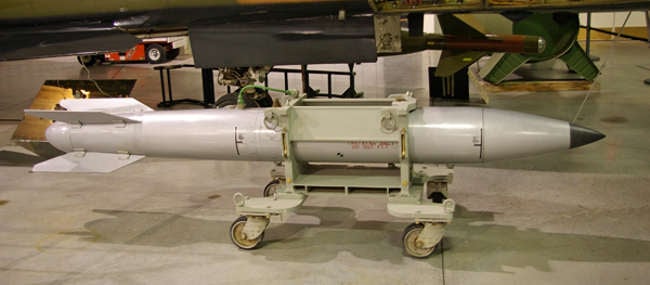
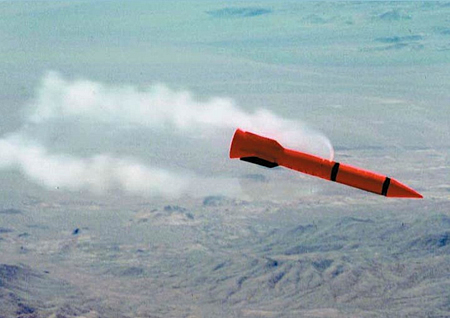
B61-11 Simulation
The Joint Test Assembly (JTA) of the B61-11
This JTA testing was undertaken by the National Nuclear Security Administration (NNSA) together with the U.S. Air Force Global Strike Command, which coincidentally is responsible for the coordination of US bombing operations directed against Libya as well as ongoing operations in Iraq and Afghanistan.
“The JTA was produced by the NNSA in support of the Joint Surveillance Flight Test Program between the Department of Defense and the NNSA” (Press release, op cit)
The Joint Test Assembly (JTA) in the case of the B61 Mod 11 nuclear bomb, requires testing the equipment of the B61-11 using a proxy conventional non-nuclear warhead. Essentially what is involved is to test all the installed equipment on the nuclear bomb and ensure its functionality without actually having a nuclear explosion. The JTA test “was built to simulate the actual B61-11 weapon configuration utilizing as much war reserve hardware as feasible. It was assembled at the Pantex plant in Amarillo, Texas and was not capable of nuclear yield, as it contained no special nuclear materials.” (Press Release, NNSA Conducts Successful B61-11 JTA Flight Test, Apr 4, 2011)
“JTA tests [are to ensure] that all weapon systems [e.g. B61-11 nuclear bomb] perform as planned and that systems are designed to be safe, secure and effective,”…. A JTA contains instrumentation and sensors that monitor the performance of numerous weapon components [e.g of the B61-11] during the flight test to determine if the weapon functions as designed. This JTA also included a flight recorder that stored the bomb performance data for the entire test. The data is used in a reliability model, developed by Sandia National Laboratories, to evaluate the reliability of the bomb. (Ibid)
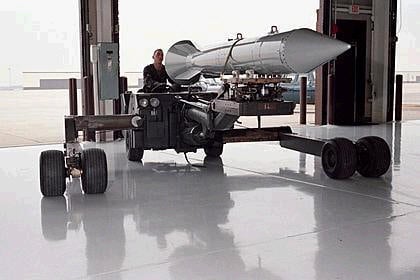
B61 Model 11 nuclear bomb at Whiteman Air force base
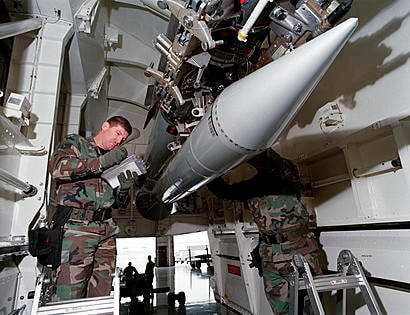
The B-2 Spirit Stealth Bomber operating out of the Whiteman Air Force Base was reported to have “delivered and released” the B61-11 JTA at the Tonopah Test Range in Nevada, which is routinely used to test nuclear ordnance. (See Press Release, op cit.).
The Tonopah Test Range while owned by the US Department of Energy, is managed and operated by Sandia National Laboratories, a division of America’s largest weapons producer Lockheed-Martin (under permit with the NNSA). (See this)
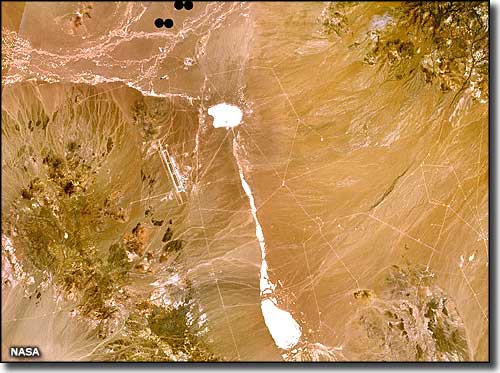
Aerial View of Tonopah Test Range where the B61 11 JTA was tested using a B-2 Spirit Stealth bomber. Source NASA.
The Deployment of B-2 Stealth Bombers to Libya
Why were these JTA tests of the equipment and functionality of a tactical nuclear weapon scheduled shortly after the onset of the Libya bombing campaign?
Why now?
Is the timing of these tests coincidental or are they in any way related to the chronology of the Libya bombing campaign?
It is worth noting that the U.S. Air Force Global Strike Command was in charge of both the JTA tests of the B61-11 as well as the deployment of three B-2 Spirit Stealth bombers to Libya on March 19.
“Three B-2 Spirit bombers, piloted by two men each, made it back after the 11,418-mile round trip from the Whiteman Air Force Base in Missouri – where they are kept in special hangars – to Libya, where they hit targets on forces loyal to Colonel Gaddafi and back again.”(Libya-crisis-B2-stealth-bombers-25-hour-flight-Missouri-Tripoli, Daily Mail, March 21, 2011)
In other words, both the deployment of the B-2s to the Libya war theater as well as the JTA test (using the B-2 bomber for delivery) were coordinated out of Whiteman Air Force base.
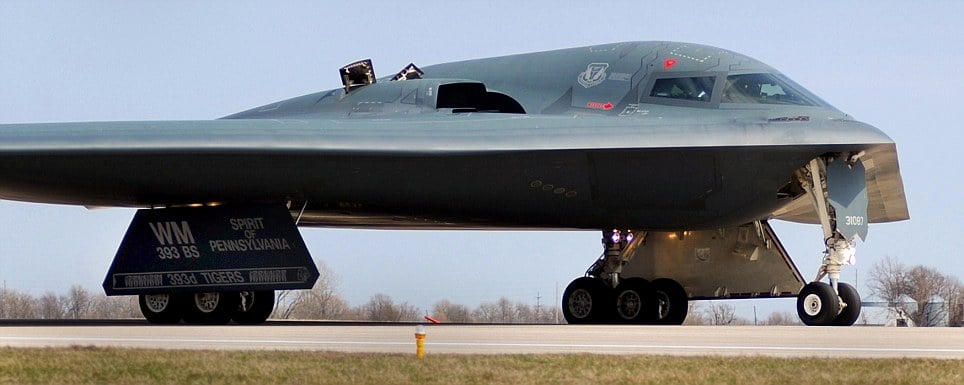
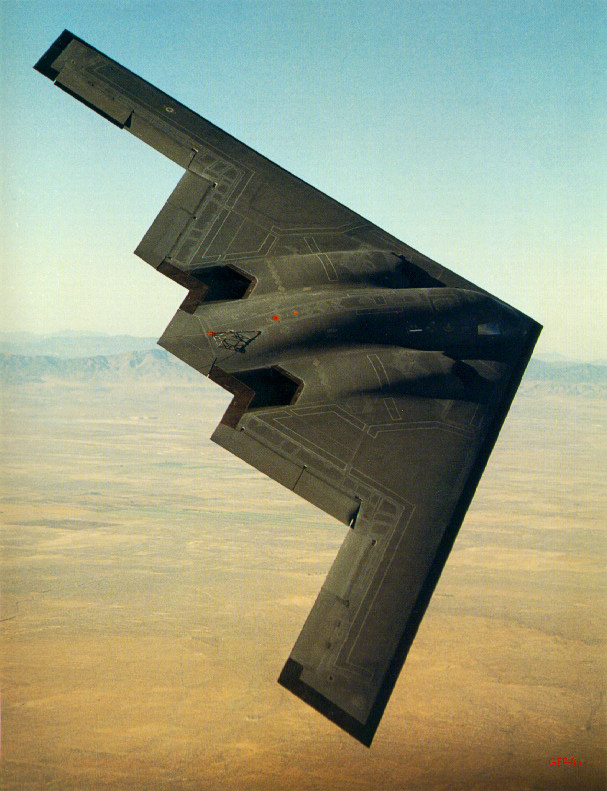
“Humanitarian war” is carried out through a “Shock and Awe” Blitzkrieg. Three B-2 Spirit Stealth bombers were sent on a bombing mission at the very outset of the Libya bombing campaign. According to the reports, they returned to Whiteman Air Force base on March 21st. The reports suggest that the three B-2s were carrying bunker buster bombs with conventional warheads.
The report suggests that the B-2 Stealth bombers dropped 45 one ton satellite guided missiles on Libya, which represents an enormous amount of ordnance: “At $2.1bn, they are the most expensive warplanes in the world and rarely leave their climate-controlled hangars. But when it does, the B-2 bomber makes a spectacularly effective start to a war – including during this weekend’s aerial attack on Libya’s air defences. (Daily Mail, March 21, 2011, op cit)
While we are not in a position to verify the accuracy of these reports, the 45 one-ton bombs correspond roughly to the B-2 specifications, namely each of these planes can carry sixteen 2,000 pound (900 kg) bombs.
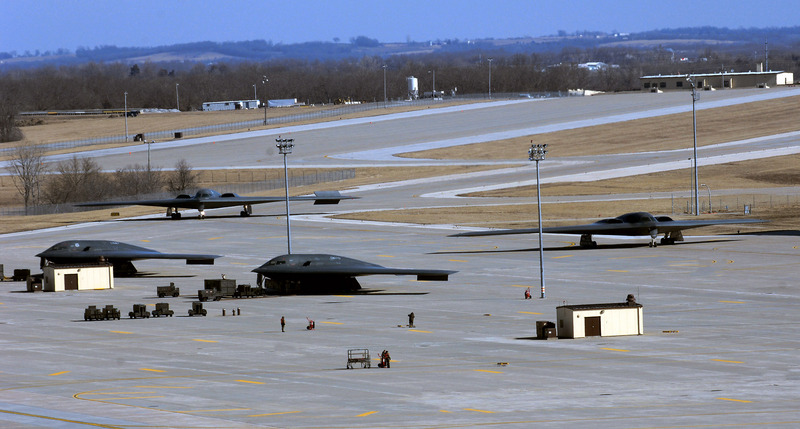
Whiteman Air Force Base
Concluding Remarks: The Decision to Use Nuclear Weapons
Through a propaganda campaign which has enlisted the support of “authoritative” nuclear scientists, the B61-11 “mini-nuke” is presented as an instrument of peace rather than war.
In an utterly twisted logic, low yield tactical nuclear weapons are presented as a means to building peace and preventing “collateral damage”.
In this regard, US nuclear doctrine ties in with the notion that the US-NATO war under Operation Odyssey Dawn is a humanitarian undertaking.
The important question addressed in this article is whether the recent test of a B61-11 is “routine” or was it envisaged by the DoD directly or indirectly in support of Operation Odyssey Dawn, implying the possible deployment of mini nukes at some future stage of the Libya bombing campaign. There is no clear-cut answer to this question.
It should be emphasized, however, that under the doctrine of “pre-emptive nuclear war” mini nukes are always deployed and in “a state of readiness” (even in times of peace). Libya was the first “rogue state” to be tagged for a nuclear attack in 1996 prior to the approval of the mini nukes for battlefield use by the US Congress.
The Pentagon claims that “mini-nukes” are harmless to civilians because “the explosion takes place under ground”. Not only is the claim of an underground explosion erroneous, each of these ‘mini-nukes’, constitutes – in terms of explosion and potential radioactive fallout – a significant fraction of the atom bomb dropped on Hiroshima in 1945….
We are at a dangerous crossroads: The rules and guidelines governing the use nuclear weapons have been “liberalized” (i.e. “deregulated” in relation to those prevailing during the Cold War era). The decision to use low yield nuclear nuclear weapons (e.g. against Libya) no longer depends on the Commander in Chief, namely president Barack Obama. It is strictly a military decision. The new doctrine states that Command, Control, and Coordination (CCC) regarding the use of nuclear weapons should be “flexible”, allowing geographic combat commanders to decide if and when to use of nuclear weapons:
Known in official Washington, as “Joint Publication 3-12”, the new nuclear doctrine (Doctrine for Joint Nuclear Operations , (DJNO) (March 2005)) calls for “integrating conventional and nuclear attacks” under a unified and “integrated” Command and Control (C2).
It largely describes war planning as a management decision-making process, where military and strategic objectives are to be achieved, through a mix of instruments, with little concern for the resulting loss of human life.
Military planning focuses on “the most efficient use of force”, i.e. an optimal arrangement of different weapons systems to achieve stated military goals. In this context, nuclear and conventional weapons are considered to be “part of the tool box”, from which military commanders can pick and choose the instruments that they require in accordance with “evolving circumstances” in the “war theatre”. (None of these weapons in the Pentagon’s “tool box”, including conventional bunker buster bombs, cluster bombs, mini-nukes, chemical and biological weapons are described as “weapons of mass destruction” when used by the United States of America and its “coalition” partners). Michel Chossudovsky, Is the Bush Administration Planning a Nuclear Holocaust? Global Research, February 22, 2006
*
Note to readers: Please click the share button above. Follow us on Instagram and Twitter and subscribe to our Telegram Channel. Feel free to repost and share widely Global Research articles.
ANNEX The B-2 Spirit Stealth Bomber
The B-2 Spirit aircraft is described as “deadly and effective’ yet at the same time it is upheld as an instrument of “humanitarian warfare”. Used at the outset of Operation Odyssey Dawn, this aircraft has the mandate under UN Security Councill resolution 1973 to “protect the lives of civilians”.
“An assessment published by the USAF showed that two B-2s armed with precision weaponry can do the job of 75 conventional aircraft. That makes it a powerful weapon to strike targets including bunkers, command centres, radars, airfields, air defences.” (Ibid) The mission is said to have have dropped a total of 45 one ton satellite guided missiles, which broadly corresponds to the 15 out of the 16 2000 pound bombs mentioned above.(Ibid)
The B-2 Spirit as carrier of the B61 mod 11 bunker buster bomb, is equipped to accommodate 16 B61-11 mini-nukes of about 1,200 lb (540 kg).
See the following videos:
Northrop Grunman Video Clip on the B-2
Military PR videoclip on the B-2
The B-2 was brought down by the Yugoslav air defense system in 1999, which the video does not mention
Returning to Whiteman Air force base on March 21, see this and this
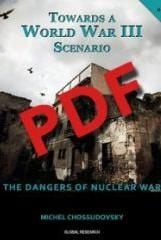 “Towards a World War III Scenario: The Dangers of Nuclear War”
“Towards a World War III Scenario: The Dangers of Nuclear War”
by Michel Chossudovsky
Available to order from Global Research!
ISBN Number: 978-0-9737147-5-3
Year: 2012
Pages: 102
PDF Edition: $6.50 (sent directly to your email account!)
Michel Chossudovsky is Professor of Economics at the University of Ottawa and Director of the Centre for Research on Globalization (CRG), which hosts the critically acclaimed website www.globalresearch.ca . He is a contributor to the Encyclopedia Britannica. His writings have been translated into more than 20 languages.
Reviews
“This book is a ‘must’ resource – a richly documented and systematic diagnosis of the supremely pathological geo-strategic planning of US wars since ‘9-11’ against non-nuclear countries to seize their oil fields and resources under cover of ‘freedom and democracy’.”
–John McMurtry, Professor of Philosophy, Guelph University
“In a world where engineered, pre-emptive, or more fashionably “humanitarian” wars of aggression have become the norm, this challenging book may be our final wake-up call.”
-Denis Halliday, Former Assistant Secretary General of the United Nations
Michel Chossudovsky exposes the insanity of our privatized war machine. Iran is being targeted with nuclear weapons as part of a war agenda built on distortions and lies for the purpose of private profit. The real aims are oil, financial hegemony and global control. The price could be nuclear holocaust. When weapons become the hottest export of the world’s only superpower, and diplomats work as salesmen for the defense industry, the whole world is recklessly endangered. If we must have a military, it belongs entirely in the public sector. No one should profit from mass death and destruction.
–Ellen Brown, author of ‘Web of Debt’ and president of the Public Banking Institute

